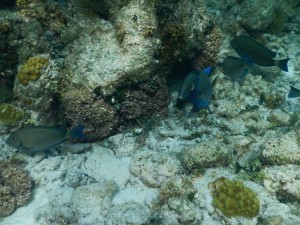Our last day here on the reef has been a little sad for me. I will absolutely be coming back here at some point in my life, but leaving tomorrow is gonna be difficult for me.
We started the day by wandering around in the back reef and collecting biodiversity in a bucket so we could identify it. I identified a species of chiton (the fuzzy chiton) and some genus of snails (cerithium and trochus snails). We also found a donkey dung sea cucumber, some box jellies, some huge hermit crabs that were using queen conch shells, and a few mantis shrimp.
As we were collecting stuff I got stung by something on my elbow and it was hurting for the next couple hours. Eventually it calmed down, but I’m still not sure what stung me. Possibly some kind of jelly.
In the afternoon we dissected lion fish to look at their size and the contents of their stomachs. Then we made lion fish ceviche which we will be eating any minute now.
After the lion fish dissection, we boated over to south-west caye and had a few drinks and watched the sun set. This place is so beautiful that it’s impossible to describe in pictures or words. I sat and watched the stars for awhile on the dock and thought about how amazing it would be to see this many stars every night. I’m gonna miss this when I got back to Houston. Despite the stings, bug bites, rashes, and layers of dirt and salt, I would love to spend huge quantities of my life here.















